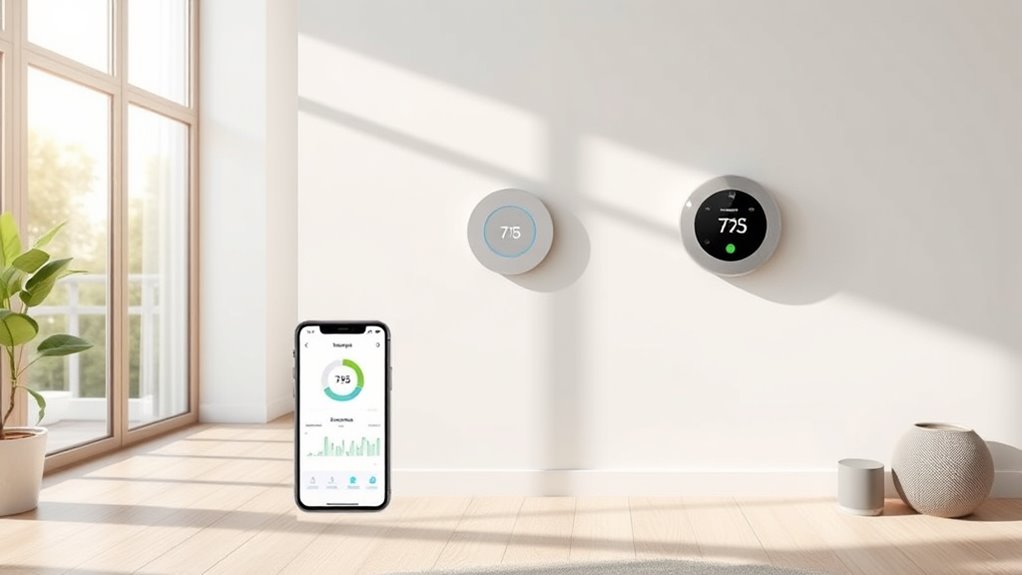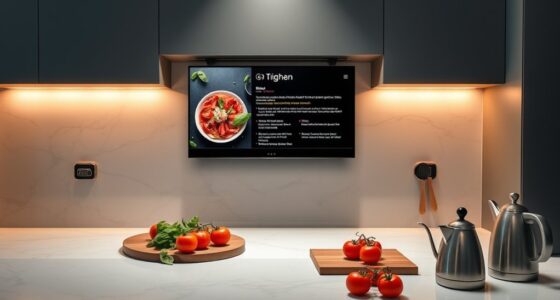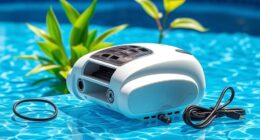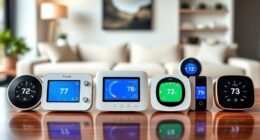Smart home devices can help you save money on utilities by automating energy management and optimizing efficiency. Smart thermostats learn your schedule and adjust temperatures, saving up to 15% on heating and cooling, while smart lighting reduces waste with motion sensors and scheduling. Leak detection and smart sprinkler systems prevent water waste, and smart plugs cut standby power. With features like real-time monitoring, you can identify high consumption and make smart adjustments, leading to noticeable savings over time. If you want to discover how to maximize these benefits, keep exploring.
Key Takeaways
- Smart thermostats optimize heating and cooling, reducing energy bills by up to 15%.
- Automated lighting and sensors cut electricity use, saving up to 26% on utility costs.
- Water-saving systems and leak detection prevent waste, lowering water expenses.
- Energy monitoring devices identify high consumption, enabling targeted savings of 8-30%.
- Remote control and scheduling ensure appliances run efficiently during off-peak hours, reducing overall utility costs.
How Smart Thermostats Reduce Heating and Cooling Costs
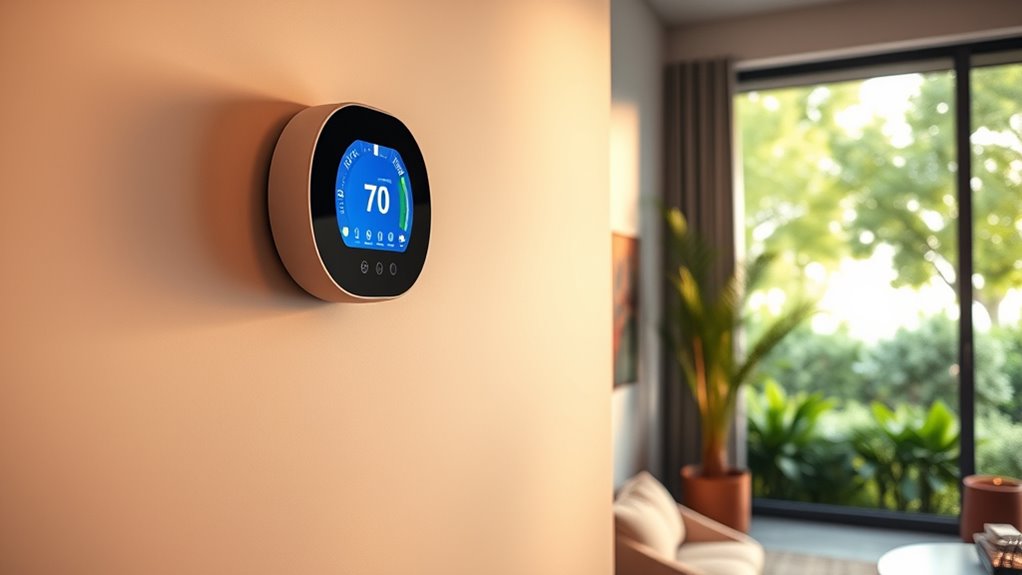
Smart thermostats help you cut heating and cooling costs by automatically optimizing your home’s temperature settings. They improve energy efficiency by learning your household schedule and adjusting temperatures when you’re away or asleep, reducing unnecessary energy use. Additionally, they can integrate with other smart home devices like smart lighting to further enhance energy savings. Devices like Google Nest and Ecobee make it easy to control your home’s climate remotely, so you can adjust the temperature before you arrive or after leaving. Automated temperature adjustments based on outdoor weather data help maintain comfort without wasting energy. These smart thermostats can save you up to 10-15% on your heating and cooling bills, with Energy Star-rated models reducing HVAC energy use by about 8%. Incorporating privacy policies and data management features, many smart thermostats ensure your personal information is protected while optimizing energy use. Moreover, some models can detect occupancy patterns to maximize energy savings, helping to reduce utility costs even further. They also utilize advanced algorithms to adapt to your preferences, enhancing efficiency and comfort. Leveraging insights from sustainable materials, these devices promote eco-friendly energy consumption while helping you achieve better energy savings and reduce your overall utility bills. Overall, they help you achieve better energy savings while keeping your home comfortable year-round.
The Impact of Smart Lighting on Energy Consumption
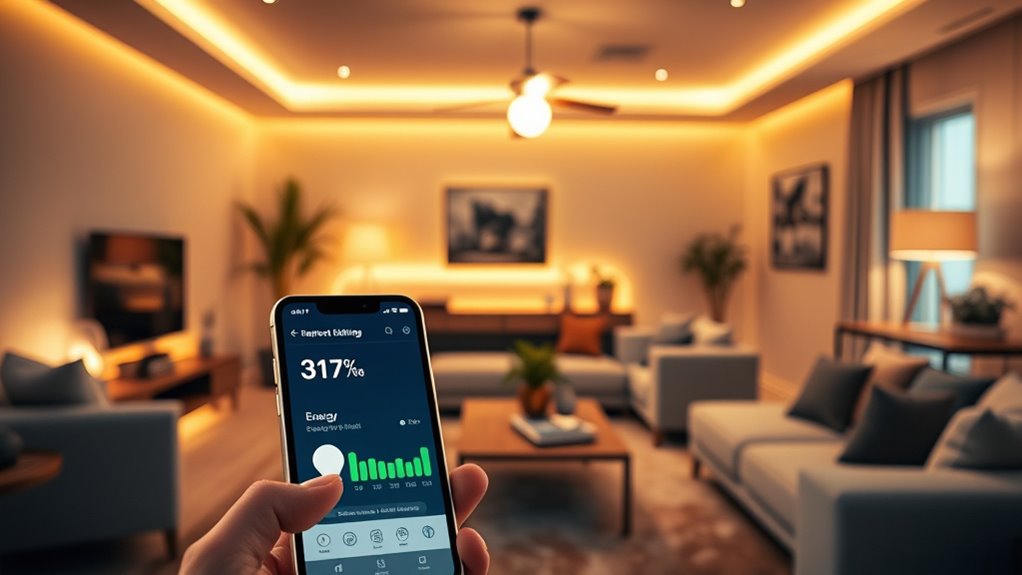
Smart lighting helps you save energy by adjusting brightness and color temperature automatically, reducing unnecessary power use. Using motion sensors or scheduling keeps lights off when rooms are empty, cutting down waste. These controls not only boost efficiency but also lead to noticeable savings on your energy bills over time. Additionally, integrating automation technologies can further optimize your energy consumption by making your smart lighting system more responsive to your habits. Implementing energy-efficient lighting strategies further enhances savings and sustainability, especially when combined with monitoring energy use to track and adjust consumption patterns effectively. Understanding lighting design principles can also help maximize the impact of your smart lighting system on energy savings. Regularly updating your smart home devices ensures you benefit from the latest energy-saving features and improvements.
Energy Efficiency Gains
Lighting accounts for a significant portion of household energy use, but advancements in technology are helping homeowners cut costs and reduce waste. Smart lighting, especially LED smart bulbs, can cut energy consumption by up to 90% compared to traditional bulbs.
With home automation features like occupancy sensors and scheduling, you can reduce unnecessary light usage, saving about 10-15% on lighting costs. Geofencing turns off or dims lights when you’re away, further lowering energy waste.
These smart devices allow you to adjust brightness and color, optimizing energy use based on your needs. Additionally, incorporating Glycolic Acid Exfoliating Toner in your skincare routine can improve overall skin health and reduce the need for frequent product changes, indirectly contributing to savings by maintaining skin vitality. Implementing energy-efficient lighting strategies can further enhance your home’s overall efficiency, leading to additional savings on utility bills. Furthermore, understanding home energy consumption patterns can help identify areas for further efficiency improvements. Overall, smart lighting systems can boost your home’s energy efficiency, leading to savings of up to 26% on utility bills.
This makes smart lighting a smart choice for reducing household energy expenses.
Automated Lighting Controls
Automated lighting controls markedly enhance the energy-saving potential of smart lighting systems by ensuring lights are only on when needed. With smart lighting, features like occupancy sensors and geofencing automatically turn off lights when rooms are unoccupied, reducing energy use by up to 90%. Utilizing vertical storage solutions can further optimize space and reduce clutter, making it easier to manage lighting and other systems efficiently. Scheduling smart bulbs to switch on and off at specific times prevents unnecessary lighting, lowering costs by 25-30%. LED bulbs, which consume at least 75% less energy than incandescent bulbs, can also be dimmed or color-adjusted to optimize efficiency. Integrating lighting controls with your smart home system allows brightness adjustments based on natural sunlight, further cutting energy consumption. These automation features significantly boost home efficiency, contributing to overall energy savings of up to 15%.
Saving Water With Smart Sprinkler and Leak Detection Systems
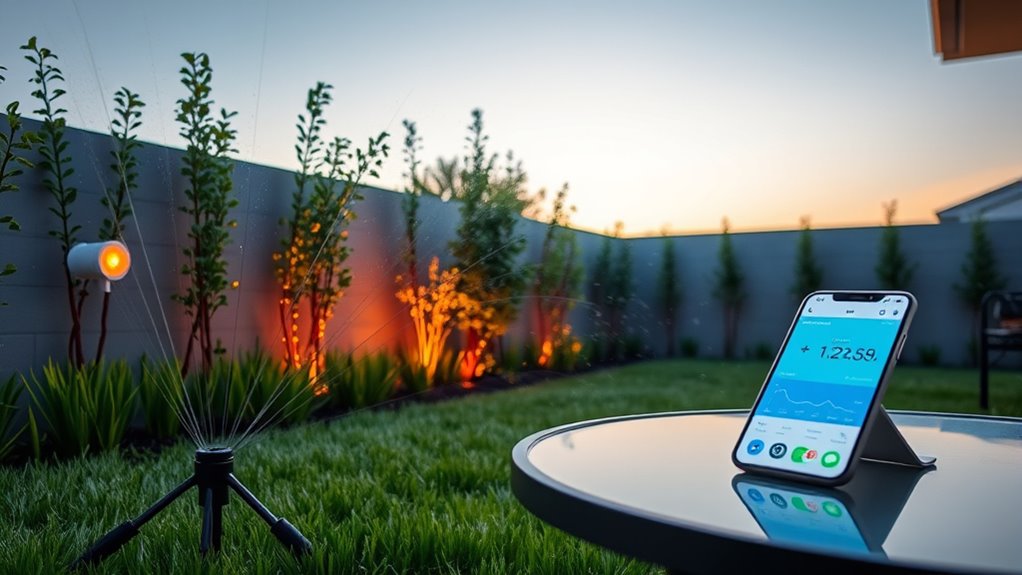
By using advanced sprinkler systems that rely on weather data and soil moisture sensors, you can considerably cut down on water waste, saving nearly 7,600 gallons each year. A smart sprinkler system adjusts watering schedules based on real-time conditions, ensuring your lawn gets just the right amount of water. Additionally, practicing stillness during routine checks can help you become more mindful of water usage and detect leaks early through increased awareness. These sensors can also monitor water pressure, helping prevent pipe bursts and further water loss. Regular maintenance and timely inspections can further enhance water conservation efforts and prevent costly repairs. Leak detection sensors placed under sinks or near water heaters can alert you immediately if there’s a leak, preventing water waste and costly damage. Smart shut-off valves automatically turn off the water supply when a leak is detected, even if you’re away. These water leak alerts help you respond quickly, reducing water waste and lowering your utility bills. Incorporating advanced leak detection technology can optimize your water management and provide peace of mind. Implementing smart devices also supports the use of unique and wicked planters and other eco-friendly gardening tools, contributing further to sustainable water use.
Benefits of Smart Plugs for Appliance Efficiency
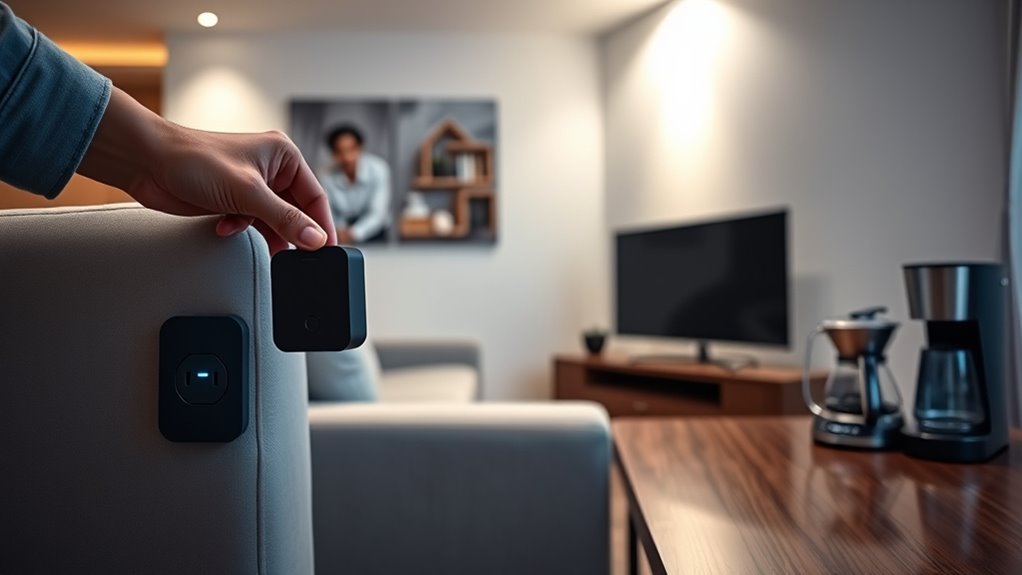
Smart plugs help you cut down on energy waste by turning off appliances when they’re not needed, especially in standby mode. With scheduling and automation, you can easily set devices to run only when necessary, saving you money on utility bills. Additionally, real-time energy monitoring makes it simple to identify high-consuming devices and optimize their use, leading to even greater savings. Predictive analytics can further enhance your ability to forecast and manage energy consumption effectively.
Reduce Standby Power
Reducing standby power is a simple yet effective way to lower your household energy use, and smart plugs make this process easier. Standby power, or phantom loads, can account for up to 10% of your energy consumption, wasting money and resources.
With smart plugs, you can completely turn off devices when they’re not in use, preventing unnecessary power draw. Automation features allow you to schedule or remotely control electronics and chargers, cutting down on energy waste.
Many smart plugs provide real-time energy usage data, helping you identify inefficient devices. By eliminating unnecessary standby power, you not only improve appliance efficiency but also save money on utility bills—potentially $20–$50 annually.
Implementing industry trends in your home’s energy management can further optimize the savings and efficiency of your devices.
Smart plugs are a simple tool to reduce power consumption and enhance your home’s energy savings.
Automate Device Schedules
Automating device schedules with smart plugs allows you to optimize energy use without constant manual intervention. With smart devices, you can set device schedules to turn appliances on or off at specific times, such as during off-peak hours, which can lower your energy costs. Smart plugs give you remote control, so you can power devices only when needed, preventing unnecessary waste. They help eliminate standby power, reducing phantom energy drain from electronics. Additionally, scheduling your devices in accordance with energy efficiency standards can further enhance your utility savings and ensure safe operation. Implementing these practices aligns with sustainability principles of conservation and responsible energy use. Regularly monitoring device performance can help identify energy-saving opportunities and improve overall efficiency.
How Automated Window Coverings Improve Home Climate Control

Automated window coverings play a crucial role in enhancing your home’s climate control by managing sunlight and heat gain throughout the day. By adjusting your shades and blinds based on sunlight, you can considerably reduce summer heat gain by up to 77%, lowering cooling costs.
These smart home devices help maintain consistent indoor temperatures, reducing your reliance on HVAC systems. Scheduling your window treatments to close during peak sunlight hours or open during winter improves insulation, keeping your home warmer or cooler as needed.
This targeted control not only boosts comfort but also delivers energy savings of about 10-15%. Automating your window coverings also mimics occupancy, enhancing security while preventing energy waste, making your home more efficient and cost-effective.
Smart Devices That Track and Manage Overall Energy Use
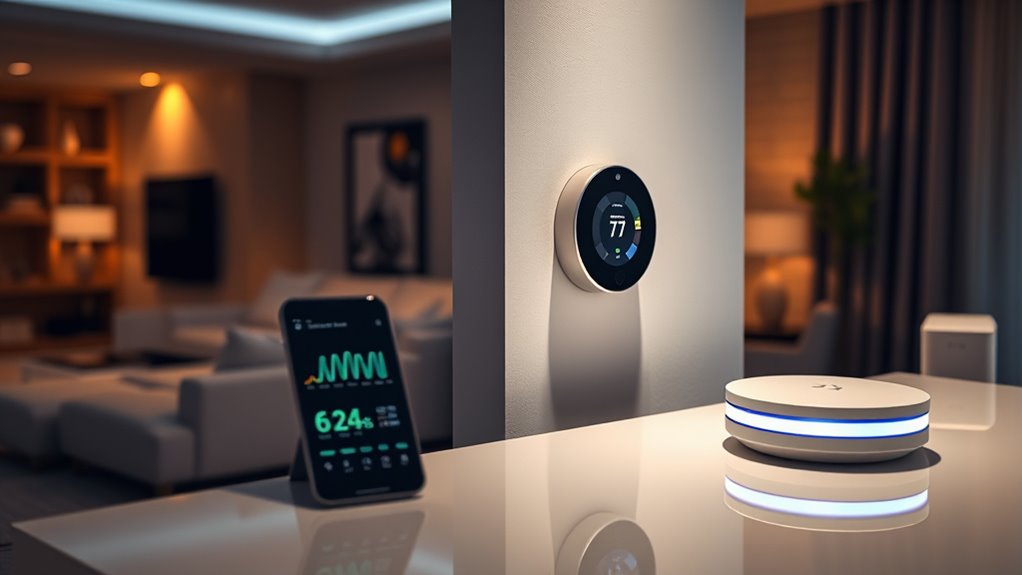
Smart devices with real-time monitoring give you immediate insight into your energy use, helping you spot high-consuming appliances.
With data-driven strategies, you can adjust your habits or automate devices to operate more efficiently. These tools make it easier to reduce waste and lower your energy bills without sacrificing comfort.
Real-Time Monitoring Capabilities
Real-time monitoring capabilities enable you to see how much energy your appliances and systems use at any given moment. This instant data enhances your energy management by revealing high-energy-consuming appliances and system inefficiencies.
Smart meters and energy management platforms display detailed insights, making it easier to identify where you can cut back. Many devices send alerts about unusual energy spikes, allowing quick action to prevent waste.
Integration with mobile apps offers remote control, so you can adjust your energy use even when you’re away. On average, homes with real-time monitoring see about an 8% reduction in energy bills.
This real-time visibility helps you make smarter choices, optimize your energy use, and save money on utilities over time.
Data-Driven Efficiency Strategies
By using home energy management systems (HEMS), you can substantially cut your energy bills through thorough monitoring and control of your appliances. Smart devices that track energy consumption give you detailed data, helping you identify high-energy appliances and adjust your habits for better efficiency.
Automation features, like scheduling and alerts, optimize device operation, preventing unnecessary energy use and saving up to $180 annually. Integrating smart meters and sensors allows for precise measurement of energy flow, enabling data-driven decisions to improve overall efficiency.
These insights not only reduce your bills but can also qualify you for utility rebates and incentive programs. By leveraging these smart devices and their detailed data, you’re taking proactive steps toward smarter, more cost-effective energy use.
Cost Savings From Smart Appliance Integration
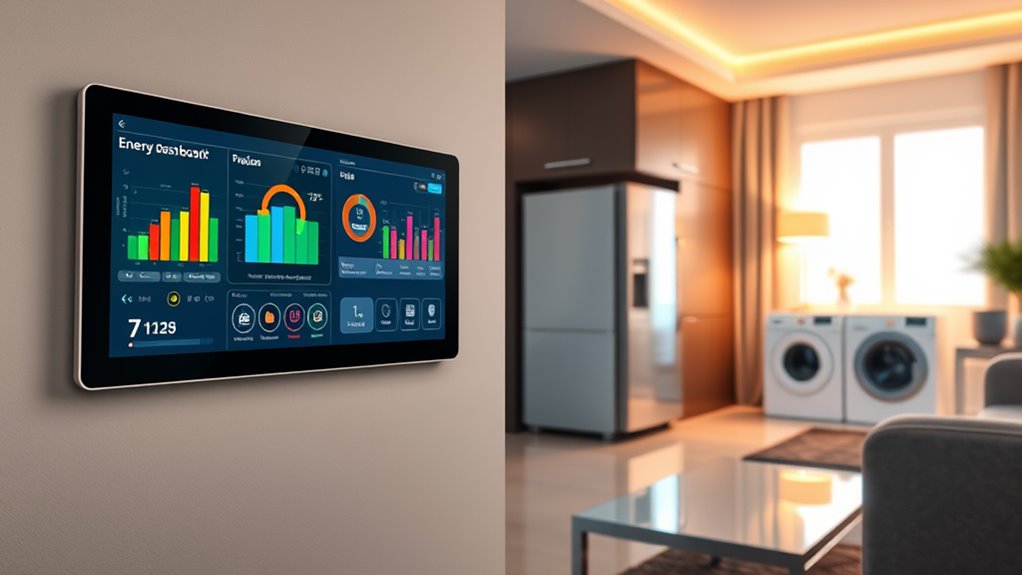
Integrating smart appliances into your home can considerably reduce your utility bills by optimizing energy and water use. Smart appliances like Energy Star-rated washers and dryers use up to 35% less water and 25% less energy, directly lowering your utility bills.
Automation features ensure they operate during off-peak hours, reducing energy costs and demand charges. Smart dishwashers and laundry machines can detect load size and adjust cycle times, conserving water and electricity.
Smart thermostats work with these appliances to coordinate heating, cooling, and appliance use for maximum efficiency. Monitoring features provide real-time data on energy consumption, allowing you to make targeted adjustments.
Understanding the Long-Term Financial Benefits of Smart Home Technology
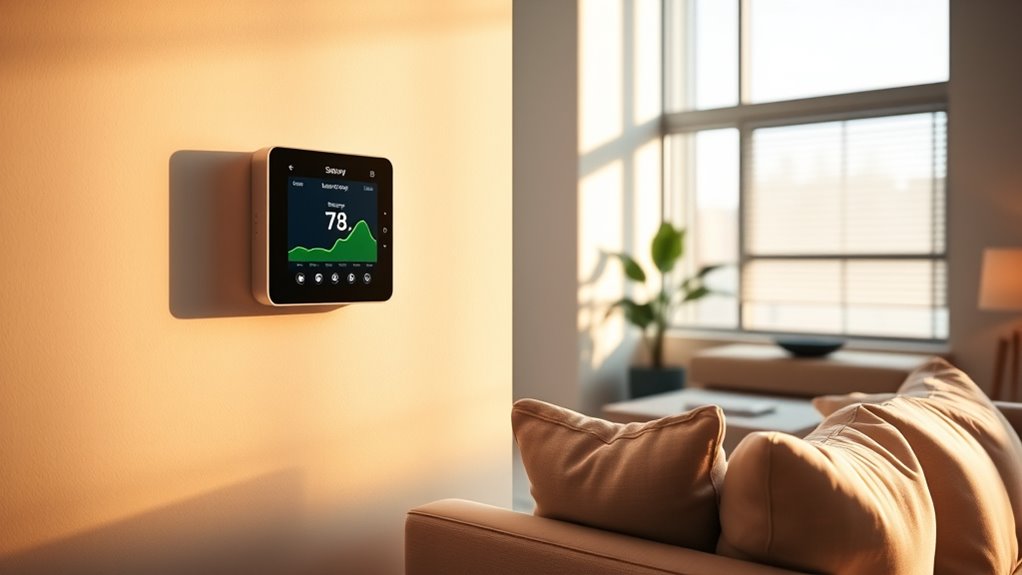
Understanding the long-term financial benefits of smart home technology reveals how these devices can pay for themselves over time. Smart devices like thermostats and appliances deliver significant energy savings, often reducing utility bills by 10-30%.
Smart thermostats, in particular, can cut heating and cooling costs by up to 26%, with most homeowners recouping their investment within a year or two. Automation features optimize water and energy use, preventing waste and saving about $180 annually.
When integrated into home energy management systems, smart devices can further lower costs by up to 8%. Although smart home technology requires an initial investment, the ongoing savings from improved water management, energy efficiency, and reduced utility bills make it a smart financial decision in the long run.
Tips for Renters to Maximize Savings With Portable Smart Devices
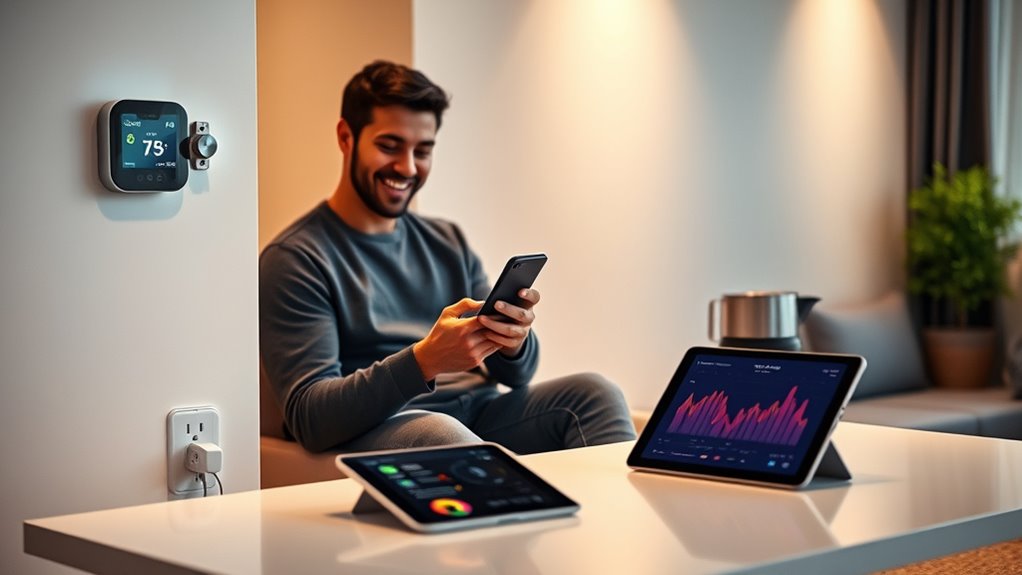
Renters can substantially reduce their energy bills by using portable smart devices that are easy to set up and remove without permanent modifications. Portable smart devices, like smart power strips and meters, help you monitor energy use and identify high-usage devices. This awareness allows you to implement simple habits to cut utility bills and maximize energy savings.
Automation features enable you to control lighting and appliances remotely, ensuring they’re turned off when not needed. Some utility companies offer rebate programs that cover the cost of these devices, making them more affordable.
While smart thermostats may require landlord approval, portable Wi-Fi-enabled options can still lower heating and cooling costs by around 10-12%. Overall, these tools empower renters to optimize their energy consumption effortlessly.
Key Features to Look for in Smart Devices to Maximize Utility Savings
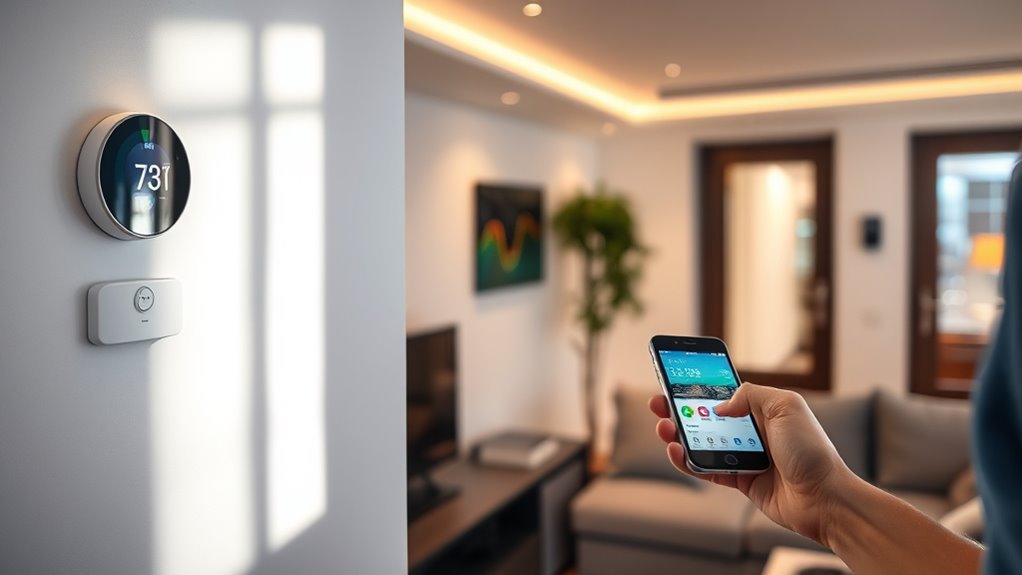
To maximize your utility savings with smart devices, it’s essential to choose models that include key features like scheduling and automatic shutdown. These functions prevent unnecessary energy use, helping your home run more efficiently. Look for smart devices that offer real-time alerts and notifications for high energy consumption, so you can make quick adjustments. Compatibility with your existing home automation system simplifies control and boosts energy-saving potential. Additionally, select devices that provide energy consumption data and insights, enabling targeted savings. Prioritize products with ENERGY STAR certification or rebate eligibility to maximize cost benefits.
| Feature | Benefit |
|---|---|
| Scheduling & Automatic Shutdown | Reduce unnecessary energy use |
| Real-time Alerts & Notifications | Prompt adjustments for high energy consumption |
| Compatibility with Home Automation | Streamlined control and efficiency |
| Energy Consumption Data & Insights | Identify savings opportunities |
Frequently Asked Questions
Do Smart Home Devices Use a Lot of Electricity?
Smart home devices don’t use a lot of electricity. You’ll find that smart thermostats, for example, typically consume just 2-5 watts during use, and smart light bulbs use about 9-10 watts, which is much less than traditional bulbs.
Even smart plugs draw minimal standby power. While they do use some energy, their overall consumption is low, especially considering they can help you save money through better energy management.
Does Smart Home Save Money?
Smart home devices can definitely save you money. They optimize your energy use by adjusting your thermostat, reduce lighting costs with efficient bulbs, and prevent water damage with leak detectors.
Automating appliances cuts standby power, and these savings often cover the initial investment within a year or two. So, by using smart devices, you not only enhance convenience but also lower your utility bills over time.
Do Smart Thermostats Actually Save You Money?
Smart thermostats actually save you money by optimizing your home’s heating and cooling. They learn your routines and adjust settings automatically, cutting down on energy waste.
With energy-efficient models like Nest or Ecobee, you can typically recover your initial cost within a year or two. Plus, monitoring outdoor temps and occupancy helps prevent unnecessary usage, lowering your bills by around $50 or more annually.
Does Smart Energy Save You Money?
Smart energy devices are like a financial GPS guiding you to savings. They can substantially cut your utility bills by optimizing heating, cooling, and lighting.
With smart thermostats, you might save 10-15%, while smart lighting and power strips can slash your energy costs further. Monitoring systems help you identify waste, enabling smarter choices.
Conclusion
Smart home devices can genuinely cut your utility bills when used wisely. By automating heating, lighting, and appliances, you optimize energy use and reduce waste. While some may think smart tech is costly upfront, the long-term savings often outweigh the investment. Embracing these innovations not only saves you money but also supports a more sustainable lifestyle. So, go ahead—trust the tech and enjoy a smarter, more efficient home that pays for itself over time.
